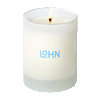Candle Care 101

Candles make everything better.
Not only do they add ambiance to any room, but our layered scents can elevate everything from your mood to an evening at home.
To get a clean and safe burn, candle care is key! Here are some essential candle care tips and candle safety guidelines to keep in mind when using LOHN candles.
Trim the wick before each use.
Before lighting your candle, be sure to trim the wick to ¼ inch. This helps ensure a clean and even burn, and reduces the risk of the flame becoming too large and causing a fire. Use a wick trimmer or scissors to trim the wick, and be sure to remove any debris or soot from the candle surface.
Keep candles away from flammable objects.
When lighting candles, it's important to keep them away from any flammable objects such as curtains, papers, or plants. Make sure your candle is placed on a stable and heat-resistant surface, such as a flat plate or candle holder, and keep it away from drafts and high traffic areas.
Don't burn candles for more than 3 hours at a time.
To prevent the candle from overheating and causing a fire, it's important to not burn it for more than 3 hours at a time. After 3 hours, allow the candle to cool and solidify before relighting it. This should go without saying but we'll say it: never leave your candles unattended!
Extinguish candles properly.
When extinguishing your candle, use our wick snuffer instead of blowing it out. This helps avoid the wick moving and causing soot. Always make sure the wick is centered and upright before relighting the candle.
Store candles properly.
When not in use, store your candles in a cool, dry place away from direct sunlight or other sources of heat. This helps preserve the scent and color of the candle, and reduces the risk of the wax melting or warping.
*
Want more candle care tips? Follow along on Instagram + TikTok where we share our best practices for longer burns, tunnel prevention, and more.
Happy burning!



Leave a comment